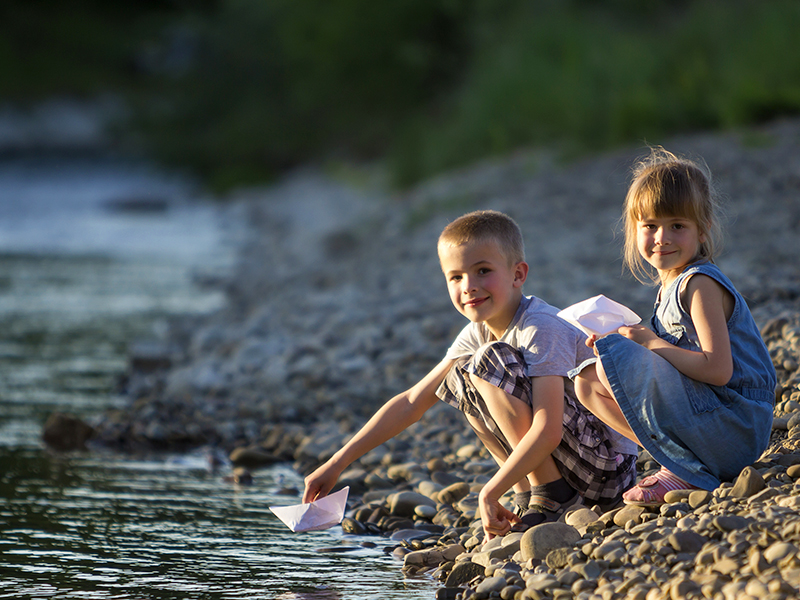School’s out for the summer and we’ve got a list of great STEAM projects for summer days! Summer days are the perfect time to explore STEAM – science, technology, engineering, arts and math – with activities perfect for the weather. So keep your cool, keep it fun and keep learning.
Sink, Float, Make a Boat
When it’s hot outside, there’s nothing like water play to stay cool. Fill a kiddie pool (or a large storage tub) with water. Collect a variety of objects that can get wet:
- Water bottles (full and empty)
- Keys
- Rubber duck or other small toys
- Apple
- Spoon
- Egg (raw or boiled)
- Cork
- Bar of soap
Have kids predict which items will sink and which will float. Then test each object. Were there any surprises? Encourage kids to speculate why some objects float and some do not.
Then using what they’ve learned about what floats and what doesn’t, have kids make boats from a variety of recycled materials. Then they can test their boats and make adjustments to improve flotation and stability.
Show off the boats in races or a boat parade with prizes for the most colorful, uniquely shaped, innovative use of materials or any other criteria you choose.
Summer Reading Suggestions
- “Things That Float and Things That Don’t” by David A. Adler provides simple explanations about density, sinking and floating for young readers.
- “Captain Kidd’s Crew Experiments with Sinking and Floating” by Mark Weakland uses a pirate story to help kinds understand density.
- In “What Floats in a Moat” by Lynne Berry, Archie the Goat has to build a boat to cross a moat and has some false starts before getting one that works.
Wish on a Shooting Star
STEAM projects for summer don’t always have to be done in the sun. Summer is a great time for star gazing – and meteor watching. The Perseid meteor showers are the perfect time to do some night sky viewing. In 2021, the best time to view the Perseid meteor showers is late evening to dawn between August 11th and August 12th.
Even though warmer evening temperatures make waiting and watching outside much more enjoyable than winter sky viewing, it can still be cool, so cozy up in a sleeping bag and have a warm drink handy. Lawn chairs can make waiting more comfortable.
Watching for meteors takes patience. Even on a peak night, you may not see much. Keep expectations low and enjoy being out at night and observing the night sky. There is plenty to see even if meteors aren’t streaking across the sky.
Meteors are often referred to as shooting stars. Have fun making your own shooting stars and wishing on them with this craft.
- Collect card stock, tissue paper, scissors, glue and a pen or marker.
- Cut large stars out of card stock.
- Glue narrow tissue paper strips to the bottom of the star. Let it dry
- Write a wish on the star.
- You can stop here and hang the shooting stars, or you can fold the star in half along the top point. Fold each side back halfway to make the star look something like a paper airplane.
- Take your stars outside and give them a toss. Watch them shoot through the sky.
Summer Reading Suggestions
- As you look up at the night sky, you might think about Henrietta Leavitt. “Look Up! Henrietta Leavitt, Pioneering Woman Astronomer” by Robert Burleigh tells the story of this early female astronomer.
- What happens when a meteorite lands? Find one answer based on a true story about what happens when a meteorite lands in a small town, in “Meteor!” by Patricia Polacco.
- “Wishing on a Star” by Fran Lee is a good introduction to constellations and night sky watching for young stargazers.
Boom! Flash! Exploring Summer Storms
Not all STEAM projects for summer require tools, and while thunderstorms can happen any time of year, they are most common during summer months. Whether your kids are frightened or fascinated by thunderstorms, understanding how they work is enlightening.
Thunderstorms form when cold and warm air masses meet. In the clouds, static electricity builds up until it is released as lightning. The sound we hear when that happens is the thunder.
One way to learn about weather is simply by observing. Do take care, though. If you see lightning or hear thunder, take shelter in a fully enclosed building or car with the windows closed
Try tracking your weather for several days, especially when storms are predicted. Some things to observe:
- Does the temperature change before, during or after a storm?
- What do the sky and clouds look like?
- Does the wind pick up or does the air get still?
- What kind of precipitation (rain, hail) do you get, if any?
- Which direction does the storm come from?
- How long does it take to get to you? How long does it last?
Employ a stopwatch to check the time between seeing lightning and hearing thunder. (Do this from a safe space inside.) For every five seconds, the storm is about a mile away.
Use dark paper and white, yellow, silver or pale blue paint to create a lightning storm on the page. Lightning can take different shapes. Observe safely from indoors and show what you see in your art. Then try creating a series of drawings or paintings that shows the changes you observed in the sky and clouds before, during and after the storm. Keep track of your STEAM projects for summer and their results, you can then share them with your teachers and friends when you go back to school.
Summer Reading Suggestions
- “Flash, Crash, Rumble, and Roll” by Franklyn M. Branley explains how thunderstorms form and shares fun facts about these powerful weather systems.
- “Thunder Cake” by Patricia Polacco is the story of a young girl frightened by summer thunderstorms and how she overcame her fear with the help of her grandmother. Try making your own thunder cake with the recipe included in the book!
- “ Geisert details this weather phenomenon through detailed illustrations.
Whether you explore the wild summer weather, the dazzling night sky or the best way to build a boat, STEAM projects for summer are a cool way to spend hot days.



